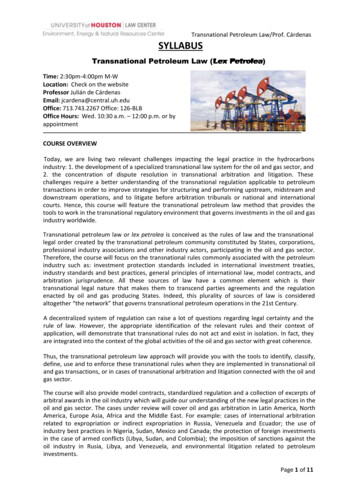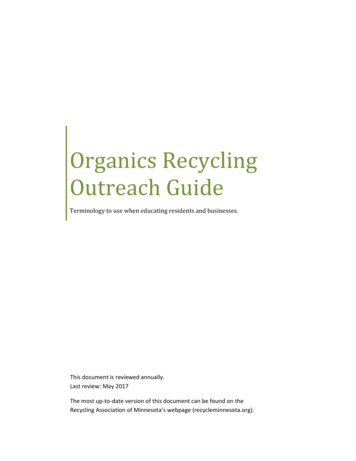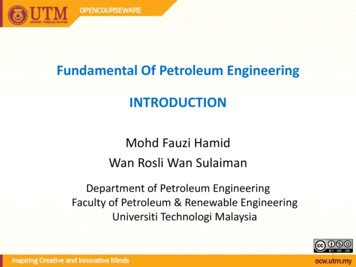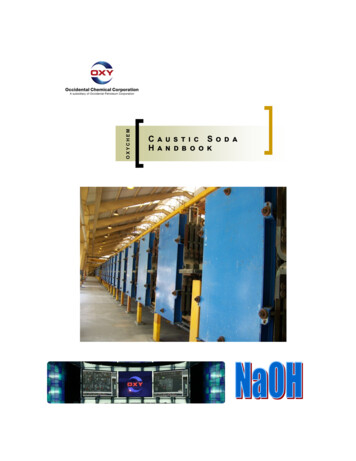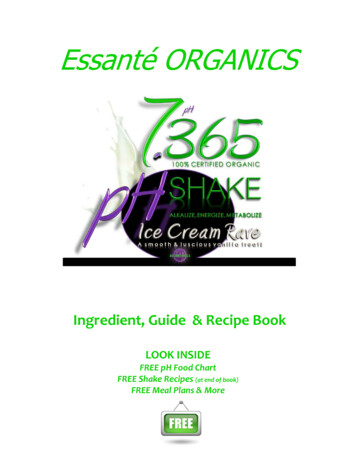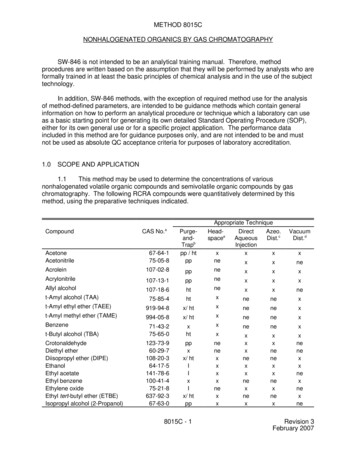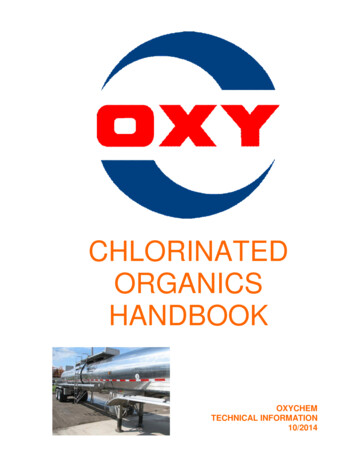
Transcription
CHLORINATEDORGANICSHANDBOOKOXYCHEMTECHNICAL INFORMATION10/2014
Dallas-based Occidental Chemical Corporation is a leading North Americanmanufacturer of basic chemicals, vinyls and performance chemicals directly andthrough various affiliates (collectively, OxyChem). OxyChem is also North America'slargest producer of sodium chlorite.As a Responsible Care company, OxyChem's global commitment to safety and theenvironment goes well beyond compliance. OxyChem's Health, Environment andSafety philosophy is a positive motivational force for our employees, and helps create astrong culture for protecting human health and the environment. Our risk managementprograms and methods have been, and continue to be, recognized as some of theindustry's best.OxyChem offers an effective combination of industry expertise, experience, on linebusiness tools, quality products and exceptional customer service. As a member of theOccidental Petroleum Corporation family, OxyChem represents a rich history ofexperience, top-notch business acumen, and sound, ethical business practices.
Table of ContentsIntroduction to Chlorinated Organics . 2Manufacturing . 2Uses and Product Grades . 4Safety and First Aid . 7Hazards . 7Respiratory Protection . 8Safety Precautions . 9First Aid . 9Toxicity . 11Regulatory . 12US Environmental Protection Agency . 12Stratospheric Ozone Depletion . 12Significant New Alternatives Policy . 13US Department of Homeland Security . 13Handling and Storage . 14Shipping . 14Tank Cars/Trailers . 14Pump Unloading . 14Tank Trailer Equipment . 16Pressure Unloading . 16Storage & Equipment . 16Maintenance of Bulk Storage Facilities . 19Storage of Non-bulk Containers . 21Spills and Precautions . 21Technical Data . 23Physical Properties . 23Product Sampling . 23Vendors of Equipment . 25Methods of Analysis . 29Further Information . 311
Introduction to Chlorinated OrganicsChlorinated OrganicsManufacturingAs a result of their physical and chemical properties,OxyChem‘s chlorinated organics have a wide rangeof applications as industrial solvents. Compared toother organic solvents, chlorinated organics exhibitunique chemical properties such as high solvency,non-flammability, low boiling point, and high vapordensity.The OxyChem Chloromethanes plant producesmethylene chloride, chloroform,and carbontetrachloride from the thermal chlorination of methylchloride. Hydrogen chloride produced in the thermalchlorination reaction is recycled back to the methylchloride process.Chlorinated organics are remarkably stable,noncorrosive to most metals, and have low rates ofevaporation and low vapor pressures.OxyChem‘s family of chlorinated organics include:Carbon Tetrachloride (tetrachloromethane)Chloroform (trichloromethane)Methylene chloride (dichloromethane)Perchloroethylene (tetrachloroethylene)Because of the difference in the properties of theseproducts, each has some particular application forwhich it is best suited.2The OxyChem chlorinated organics technology usesa versatile process to produce perchloroethylene(perc) and carbon tetrachloride (carbon tet), withanhydrous hydrogen chloride (HCl) and crude 1,2dichloroethane (EDC) by-products. A wide variety offeedstocks including C1 to C3 hydrocarbons andpartially chlorinated hydrocarbons are utilized in thisprocess. Chlorine (Cl2), in excess of stoichiometricrequirements, is reacted at high temperature with theorganic feed to produce perc and carbon tet.The organic products are separated from the excesschlorine and the HCl in a series of condensationsteps, and then further purified in a series ofdistillation columns.
Figure 1: Thermal Chloromethanes Process DiagramFigure 2: Perc Process Diagram3
Uses and Product Gradeslaboratory reagent solvent for use as a reactionmedium in the preparation of organic es, ethers, and other fine chemicals.CARBON TETRACHLORIDE (CTC)Carbon tetrachloride‘s use is restricted to nonemissive industrial applications. Although carbontetrachloride is used for some chemical processreactions today, prior to the Montreal Protocol largequantities of carbon tetrachloride were used frigerants are believed to play a role in ozonedepletion and have been phased out.The Alcohol Stabilized Grade formerly designatedas NF Grade, meets the test requirements for theNational Formulary XVII (1990) and also the testrequirements for General Use Chloroformaccording to ACS Specifications for ReagentChemicals (See current product specification sheetat www.oxychem.com). The manufacturing processfor Chloroform Alcohol Stabilized Grade does notincorporate all of the measures specified in theFood and Drug Administration‘s current GoodManufacturing Practices (cGMP).It is theresponsibility of the user to assess their use ofAlcohol Stabilized Chloroform products in food, feedor pharmaceutical related applications and s are being met.The ChloroformAlcohol Stabilized Grade is manufactured only atOxyChem‘s Wichita, KS facility.Carbon tetrachloride is tightly controlled under theMontreal Protocol as an ozone-depleting substance(ODS). As a result of the Protocol and the CleanAir Act, most uses of this and other ODSs werebanned in the developed economies around theworld in 1995.Use of carbon tetrachloride in consumer products isbanned by the Consumer Product SafetyCommission (CPSC), under the Federal HazardousSubstance Act (FHSA) 16 CFR 1500.17.Technical Grade: This grade is sold in large partinto general distribution where it is used as achemical intermediate in the preparation of dyes,plastics, resins and pesticides. It can also be usedas an industrial solvent in photography. This grademeets the test requirements of FederalSpecification O-C-291B (cancelled June 22, 2000with no replacement) and for General UseChloroform in ACS Specifications for ReagentChemicals (See current product specification sheetat www.oxychem.com).Chloroform TechnicalGrade is manufactured and drummed at theOxyChem Wichita, KS facility.OxyChem produces one grade of carbontetrachloride as Technical Grade manufactured atboth Wichita, KS and Geismar, LA facilities.OxyChem‘s carbon tetrachloride meets testrequirements for General Use according to ACSthSpecifications for Reagent Chemicals, 8 Edition,1993 and the Standard Grade according to ACSSpecifications for Reagent Chemicals (See currentproduct specification sheet at www.oxychem.com).CHLOROFORMThe major use of chloroform today is in theproduction of the chlorodifluoromethane (R-22), amajor precursor to tetrafluoroethylene, which is themain precursor to Teflon . Before the MontrealProtocol, R-22 was also a popular refrigerant. TheU.S. established hydrochlorofluorocarbons (HCFC)production limits in 2002.METHYLENE CHLORIDEMethylene chloride is a widely used chemicalorganic with a diverse number of applications. Itwas introduced as a replacement for moreflammable chlorinated organics over 60 years ago.In the mid 1990s methylene chloride replaced ions for industrial applications.Fluorocarbon Grade: This grade is the highestpurity chloroform manufactured by OxyChem. It isused as a precursor for R-22, which is thentransformed into Teflon . Chloroform FluorocarbonGrade is manufactured at both the Wichita, KS andGeismar, LA plants.Aerosol Grade: Aerosol Grade Methylene Chlorideis a higher stabilized product for applications inaerosolpackages,adhesivesandpaintformulations. Methylene chloride is used in aerosolsas a strong solvent, a flammability suppressant,vapor pressure depressant, and viscosity thinner.Methylene chloride is an important solvent inadhesive formulations where its strong dissolvingpower, low flammability and rapid drying time areAlcohol Stabilized Grade: This grade is mainlyused as a solvent in the extraction and purificationof products in the pharmaceutical industry that arenot considered to be food related. It is also used inthe purification of some antibiotics, alkaloids, andvitamins. A small percentage is also sold as aHB-500410/2014
essential. It provides adhesive formulations withstrong, instant bonding characteristics and efficacyunder extremes of temperature and humidity.Current aerosol uses of methylene chloride includespecialized spray paints and lubricants.stabilizer package for use in vapor degreasingapplications. Due to methylene chloride's relativelylow boiling point (104.2 F), this chlorinated organicis utilized in the degreasing of temperature sensitiveparts, or where immediate handling is required.Methylene chloride is used extensively for thispurpose, both for cold (room temperature) cleaningand vapor degreasing of metal parts. This productmeets the test requirements of ASTM SpecificationD 4079-00. Degreasing Grade Methylene Chlorideis manufactured at the Geismar, LA facility anddrums are available from OxyChem‘s terminal inHarvey, LA. Degreasing Grade Methylene Chloridecan also be sourced from the Lemont, IL terminalfacility.These same fast-drying, low flammability and highsolubility properties make methylene chloride anexcellent chlorinated organic in paint formulations.The additional stabilizer helps protect theequipment utilized in non-packaged aerosolapplications, as well as additional protection to theapplication substrate.The EPA suggestsmethylene chloride as a replacement for 1,1,1trichlorethane under its Significant New AlternativePolicy (SNAP). Aerosol Grade Methylene Chlorideis manufactured at the Geismar, LA facility only.Special Grade:OxyChem‘s Special GradeMethylene Chloride has become widely used toreplace fluorocarbons as an auxiliary-blowing agentin the production of slabstock flexible polyurethanefoams for the furniture and bedding industries.Evaporation of the chlorinated organic duringproduction of the urethane polymer expands thecells of the foam, reducing its density withoutmaking it stiff or rigid. The auxiliary blowing agentalso helps to control the reaction temperature,which otherwise could get sufficiently high to burn orscorch the foam interior.In foam blowingapplications, use of methylene chloride caneliminate the possibility of hard seams and canallow for ready compliance with flammabilityrequirements for upholstered furniture. SpecialGrade Methylene Chloride is manufactured at theGeismar, LA plant and drums available at theterminal in Harvey, LA. Special Grade MethyleneChloride can also be sourced from the Lemont, ILterminal facility.Decaffeination Grade:Decaffeination GradeMethylene Chloride is a low stabilized, high puritymethylene chloride used as an extractant in therecovery and purification of a wide variety ofmaterials. As a result of methylene chloride‘spowerful solvent action and stability, it is used in theextraction of naturally occurring heat-sensitivesubstances such as fats, butter, caffeine, cocoa,hops, and extraction of pharmaceutically activenatural products. Methylene chloride is used as aneffective reaction and re-crystallization solvent intheextractionofseveralpharmaceuticalcompounds and in the production of manyantibiotics and vitamins. The chemical also hasbeen used as a carrier for pharmaceutical tabletcoating for which the Food and Drug Administration(FDA) has established residue tolerances. Thisgrade meets the test requirements of the FoodChemical Codex, the ACS Specification for ReagentChemicals, for General Use, ASTM Specification D4701-00; and National Formulary 29 (See currentproduct specification sheet at www.oxychem.com).The manufacturing process for DecaffeinationGrade Methylene Chloride does not incorporate allof the measures specified in the Food and DrugAdministration‘s current Good ManufacturingPractices (cGMP). It is the responsibility of the userto assess their use of Decaffeination GradeMethylene Chloride products in food, feed, orpharmaceutical related applications and s are being met. Methylene ChlorideDecaffeination Grade is manufactured at theWichita, KS facility only.Technical Grade: OxyChem‘s Technical GradeMethylene Chloride is inhibited with one of twostabilizers: amylene or cyclohexane. Methylenechloride‘s aggressive solvency makes it an idealpaint remover and paint mask cleaner. Methylenechloride is the active ingredient in manyformulations of paint removers including industrialpaint and commercial furniture strippers, homepaint removers, and products used for aircraftmaintenance. The chemical has a unique ability topenetrate, blister, and lift a wide variety of paintcoatings. Formulations of the chemical are usedextensively in both flow-over and immersion (dip)tanks in furniture refinishing operations. For themaintenance of military and commercial aircraft, amethylene chloride based product has commonlybeen used to inspect the surface for damage. Ithas no flash point under normal use conditions andcan be used to reduce the flammability of othersubstances, decreasing the chance of in-plant fireDegreasing Grade:It is often necessary toremove grease, oil, or similar substances used aslubricants or temporary protective coatings duringmetal fabrication. This grade of methylene chloridecontains a specifically formulated three-partHB-500510/2014
or explosion. Methylene chloride is widely used inthe electronics industry for the production of printedcircuit boards. Methylene chloride is employed inthe manufacture of polycarbonate resin used for theproduction of thermoplastics. It is used as achlorinated organic in the production of cellulosetriacetate, which serves as a base for photographicfilm. Other applications include its use in thesolvent welding of plastic parts and as a releasingagent to prevent the manufactured part frompermanently bonding to the mold. This grademeets the test requirements of the Food ChemicalCodex, the ACS Specification for ReagentChemicals, General Use, ASTM SpecificationD4701-00; and National Formulary 29 (See currentproduct specification sheet at www.oxychem.com).The manufacturing process for Technical GradeMethylene Chloride does not incorporate all of themeasures specified in the Food and DrugAdministration‘s current Good ManufacturingPractices (cGMP). It is the responsibility of the userto assess their use of Technical Grade MethyleneChloride products in food, feed, or pharmaceuticalrelated applications and to determine whetherappropriate regulatory requirements are being met.The Technical Grade Methylene Chloride isproduced at both the Geismar, LA and Wichita, KSlocations. Technical Grade Methylene Chloride canalso be sourced at the Lemont, IL terminal facility.Fluorocarbon Grade: Fluorocarbon Grade Perc isused as a basic raw material in the manufacture otrifluoroethane (CFC-113), which is used inthe electronics industry. This grade of perc is alsoused in the synthesis of hydrofluorocarbon 134a(HFC-134a), and can be used for the synthesis ofhydrochlorofluorocarbon(HCFC)HCFC-123,HCFC-142b, and HCFC-141b. Fluorocarbon GradePerc is produced at the Geismar, LA facility withdrums available from the Harvey, LA terminal.Technical Grade: Technical Grade Perc serves asa carrier solvent for fabric finishes, rubber, siliconesand adhesives.It is used in paint removerformulations and printing inks and as an extractionmedium. In addition, perc is a component ofchemical masking formulations used to protectsurfaces from chemical etchings in the aerospaceand other industries. Perc is also used in woolscouring and as a solvent carrier in dyes and waterrepellents. The textile industry uses perc as aspotting agent for the removal of spinning oils andlubricants.Perchloroethylene is used as aninsulating fluid in some electrical transformers as asubstitute for polychlorinated biphenyls (PCBs).Relatively small quantities of perc are used inaerosol specialty products and paper coatings.Perchloroethylene is used in aerosol formulationsfor the automotive aftermarket, particularly for brakecleaning. These formulations provide auto repairshops with highly effective, nonflammable products.Perc Technical Grade is manufactured at theGeismar, LA facility with drums available from theHarvey, LA terminal. Technical Grade Perc canalso be sourced from the Lemont, IL e (Perc) is primarily used as achemical intermediate in the production of severalfluorinated compounds. Its other major uses are asa solvent in commercial and industrial cleaning anddegreasing of fabricated metals, and as a solvent inautomotive aerosols. OxyChem does not sellperchloroethylene into the dry cleaning application.Industrial Grade: Industrial Grade Perc is aslightly higher stabilized version of Tech GradePerc. Applications for this grade of perc are similarto those of Tech Grade, where higher inhibitorcontent is required such as cold-cleaningoperations. Perchloroethylene‘s non-flammabilityand low vapor pressure make it an effective cold(room temperature) metal cleaner, when used incompliance with applicable regulatory requirements.Its low vapor pressure contributes to reducedemissions from cold cleaning operations where it isemployed. The use of Industrial Grade versusTechnical Grade is usually at the user‘s discretion.Industrial Grade Perc is produced at the Geismar,LA facility with drums available from the Harvey, LAterminal.Industrial Grade Perc can also besourced from the Lemont, IL terminal facility.Isomerization Grade: Isomerization (Isom) GradePerc is used as a chloriding agent that provides asource of the chloride ion (Cl ) that acts as acatalyst promoter and reformer.The zation and regeneration applications are fora high purity product with a minimum amount ofoxygen and nitrogen compounds.OxyChem‘sIsomerization Grade Perc with a minimum assay of99.995% (wt.) and less than 15 ppm organicallycombined oxygen and nitrogen meets theserequirements. This grade meets the requirementsof UOP, LLC, a developer of catalyst used in therefining industry. Isom Grade Perc is manufacturedat the Geismar, LA facility with drums available fromthe Harvey, LA terminal.Vapor Degreasing Grade (VDG): Many industries,including aerospace, appliance, and automotiveHB-500610/2014
Safety and First Aidmanufacturers, use perchloroethylene for vapordegreasing metal parts during various productionstages. Perc‘s high boiling point (250 F), greatervolume of condensate, and resultant longercleaning cycle are advantageous in removing―difficult‖ soils. These include removal of highmelting point pitches and waxes, and removal oflarge quantities of water for jewelry manufacturers.Perc is particularly effective in cleaning of spotwelded seams and fine orifices and straight vaporcleaning of light metal parts. This grade meets testrequirements of FED OT-236C, Grade B (replacedby ASTM D4376-02); and ASTM D4376-02 com). VDG Perc is manufactured atthe Geismar, LA facility with drums available fromthe Harvey, LA terminal.It is recommended that employees be provided withand required to use chemical impervious clothing,gloves, boots, splash proof goggles and otherappropriate protective clothing necessary to preventany possibility of skin contact with chlorinatedorganics. Material types which may be consideredfor this service include:Teflon , Viton ,PE/EVAL, CPF3, Responder , and Tychem ,PVC, Nitrile, PVA. Face shields can augmentprotection provided by splash-proof goggles andsafety glasses, but are not intended to replacethese safety appliances. (Figure 3)References:EPA Guidance Document for the HalogenatedSolvent Cleaner NESHAP, EPA-453/R-94-081Halogenated Solvents Industry Association, WhitePapers, March 2008.http://www.hsia.org/white papers/paper.shtmlSafety & First AidHazardsAll of OxyChem chlorinated organic products arehazardous chemicals and should be handled withextreme care. Personnel should be properly trainedin the handling of chlorinated organics and shouldalways wear the proper protective equipment whenworking around chlorinated organics. All usersshould read the proper Material Safety Data Sheet(MSDS) before handling chlorinated organics. TheMSDS for any OxyChem chlorinated organic can befound at the OxyChem website: www.oxychem.comThe primary health hazard associated with the useof chlorinated organics is overexposure due to theinhalation of vapors above the OSHA PEL(Occupational Safety and Health Associationestablished Permissible Exposure Limits). Limitsare updated in the current MSDS for each product.The PEL is the allowable average concentration towhich workers may be exposed, 8 hours per day,five days a week, without adverse effects. OSHAhas also established a Short Term Exposure Limit(STEL) for methylene chloride, which is a 15 minuteaverage exposure that should not exceed 125 ppm.Likewise,theAmericanConferenceofGovernmental Industrial Hygienists (ACGIH) hasestablished Threshold Limit Values (TLV) and thesevalues can also be found in the current MSDS foreach product.Work areas employing chlorinated organics shouldbe isolated and contained. A local exhaust shouldprovide adequate ventilation to limit solvent vaporsto below exposure limits.Figure 3: Personal Protective EquipmentHB-500710/2014
dangerous to life or health (IDLH), or areascontaining unknown concentrations of chlorinatedorganics.HSDB, Hazardous Substances Databank, LastRevision Date: 20050624.Respiratory ProtectionOSHA requires that employees using respiratorsshould be properly fitted and trained in their use.Basically there are 3 types of respirators:1. Escape:In areas where the unexpectedrelease of chlorinated organic vapors may lead topotentially dangerous exposure, appropriate escaperespirators should be carried by or be readilyaccessible to each employee. The most commonrespirator used for this purpose is the mouthpiecerespirator.This respirator contains a singlecartridge with a mouthpiece and nose clip.Employees should only use this respirator whenescape times are short and airborne concentrationsof chlorinated organic vapors are low. (Figure 4)Figure 5: Full Face Air Purifying RespiratorIt is important to remember that cartridges andcanisters have a limited service life. Conditionssuch as humidity, chemical concentrations in theworkplace, other chemicals in the workplace, andfrequency of use will affect cartridge and canisterservice life. Therefore, an evaluation of workplaceconditions should be made to determine e.3. Self-Contained Breathing Apparatus: Selfcontained breathing apparatus (SCBA) can providerespiratory protection in an oxygen-deficientenvironment and in situations where unknownconcentrations of chlorinated organic vapors arepresent. The SCBA can also provide protection inemergency situations. (Figure 6)Figure 4: Mouthpiece Respirator(Escape Only)The SCBA is an atmosphere-supplying respiratorfor which the breathing air source is designed to becarried by the user (OSHA definition). A full-facemask is always used with this type of apparatus.OSHA requires that when wearing the SCBA in anImmediately Dangerous to Life and Health (IDLH)atmosphere, the SCBA must be operated in thepressure demand mode and be certified by NIOSHfor a minimum service life of thirty minutes. EscapeSCBA devices are commonly used with full facepieces or hoods, and depending on the supply ofair, are usually rated as 3 to 60 minute units.2. Air Purifying Respirators:Air purifyingrespirators contain cartridges or canisters ofabsorbent or reactive material to remove harmfulgases from breathing air. These respirators areavailable as either half face or full-face units. Forchlorinated organic service, use a cartridge orcanister designed for chlorinated organic service.(Figure 5)Where vapor concentration exceeds or is likely toexceed OSHA or NIOSH recommended exposurelevels, a cartridge or canister respirator should beused.When working in environments whereairborne concentrations are irritating to the eyes,full-face piece respirators should be used.Cartridge or canister respirators are strictly airpurifying devices and must never be used in anoxygen deficient atmosphere (less than 19.5%oxygen by volume), in environments immediatelyHB-500OSHA requires that all respirators must be NIOSHapproved and shall use breathing gas containersmarked in accordance with the NIOSH respiratorcertification standard, 42 CFR Part 84. For furtherinformation on regulations pertaining to respiratorequipment, see 29 CFR 1910.134 and 30 CFR §57.5005 For additional information see DHHS810/2014
(NIOSH) Publication No. 2005-100, NIOSHRespirator Selection Logic 2004 or Publication No.87-116, NIOSH Guide to Industrial RespiratoryProtection.Before entering tanks or opening pipelines thathave contained chlorinated organics, they should becompletely emptied and checked for vapors beforeentering. Do not enter a confined space (whichincludes tanks or pits) without following proper entryprocedures such as 29 CFR 1910.146.Good housekeeping practices are important wherechlorinated organics are used. If a chlorinatedorganic leak occurs, evacuate the area andeliminate all ignition sources. Response personnelshould wear self-contained breathing air andprotective equipment to prevent contact with vapor,liquid or hazardous decomposition products.See Page 21 of this handbook for specificrecommendations on spills and precautions.First AidFigure 6: Self-Contained Breathing ApparatusThe physiological effects of the chlorinatedhydrocarbons may vary from product to product.The following information is therefore general. Ifmore specific information is needed on anychlorinated organic, refer to the applicableOxyChem Material Safety Data Sheet or contactOxyChem Technical Service Department inWichita, KS at 800-733-1165 ext. 1.Safety PrecautionsIn the absence of air and water, chlorinatedorganics are stable in cool dry conditions.Incontact with air or water it is subject to very slow
Chlorinated Organics As a result of their physical and chemical properties, OxyChem's chlorinated organics have a wide range of applications as industrial solvents. Compared to other organic solvents, chlorinated organics exhibit unique chemical properties such as high solvency, non-flammability, low boiling point, and high vapor density.
